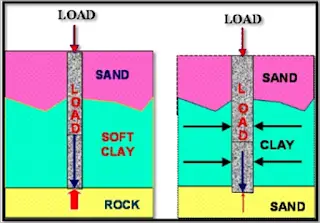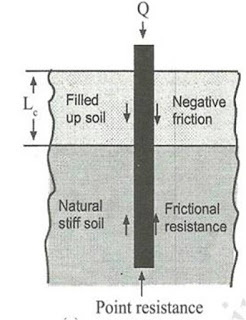Negative skin friction occurs when the settlement rate of the surrounding soils is greater than that of the piles. Some relative equations have been established to define the negative friction zone of piles. Negative skin friction is dependent on the time factor and the degree of consolidation of the soil mass and can be negligible when the soil mass is nearly completely consolidated.
The use of a concrete slab combined with beams and piles was employed to treat negative skin friction on concrete piles in soft subsoil.
A relative movement between a pile and a soil produces shear stress along the interface of the pile and the soil. Such movement can be induced by a push-load on the pile pressing it down into the soil, or by a pull-load moving it upward. `
A relative movement can also be induced when the soil settles in relation to the pile, or, in swelling soils, when the soil moves upward in relation to the pile. By definition, if the movement of the pile is downward, i.e., the shear stress induced in the pile is upward, the direction of the shear is positive. If the movement of the pile is upward, the shear stress direction is negative; accordingly, the induced shear stress is called positive or negative.
In older terminology, the induced shear along a pile was called \’skin friction\’. In modern terminology, the term \’shaft resistance\’ is used and a distinction is made between on the one hand, positive and negative shaft resistance by which is meant shear stress induced by load on the pile in the form of push-load and pull- load, respectively, and, on the other hand, negative and positive skin friction, which is shear stress induced by settling or swelling soil, respectively.
Negative skin friction produces (accumulates to) a dragload which can be very large for long piles. Johannessen and Bjerrum (1965), Bjerrum et al., (1969), and Bozozuk (1972) reported measurements of drag loads that exceed the allowable loads that ordinarily would have been applied to the piles. Bjerrum et al. (1969) also demonstrated the efficiency of coating the piles with bitumen to reduce the negative skin friction. Fellenius and Broms (1969) and Fellenius (1969) presented measurement showing that a dragload can develop alone from the reconsolidation following the disturbance caused by the pile driving. Walker and Darvall (1973) presented a comparison between bitumen coated and uncoated steel piles, and Clemente (1981) reported measurement of dragloads on coated and uncoated concrete piles. Fellenius (1975; 1979) discussed some practical aspects of bitumen coating of piles to reduce negative skin friction.

















